Our colleague Andrew Thijssen from BMS-E Motorrijder promised us an even more extensive test of the Zero DSR/X than his previous one. Once again, Electric Motorbikes Nederland was so kind to lend their motorbike to Andrew for a few days.
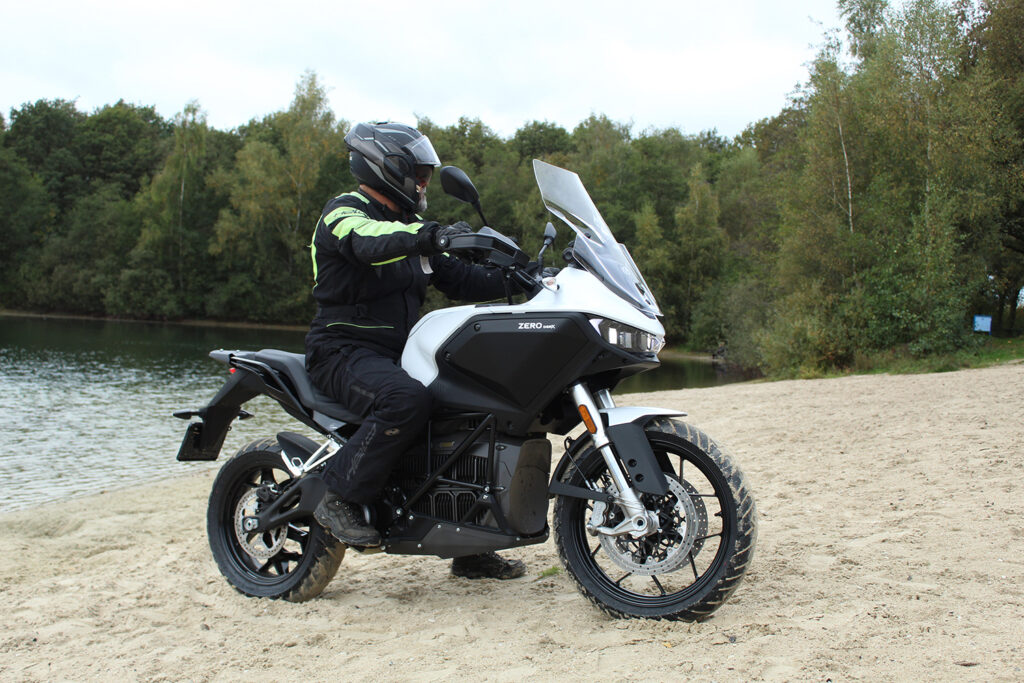
Electric motorcycles are still difficult to separate from urban mobility. The reason for this is clear: the oil-based infrastructure. The dependence, or rather the lack of charging infrastructure, scares off the “classic” manufacturer and motorcyclist.
At the moment, the adventure motorcycle is popular. Manufacturers are eagerly jumping into this lucrative segment. Electric adventure motorcycles are also now appearing on the market. In this review we’ll have a closer look at the 2023 Zero DSR/X.
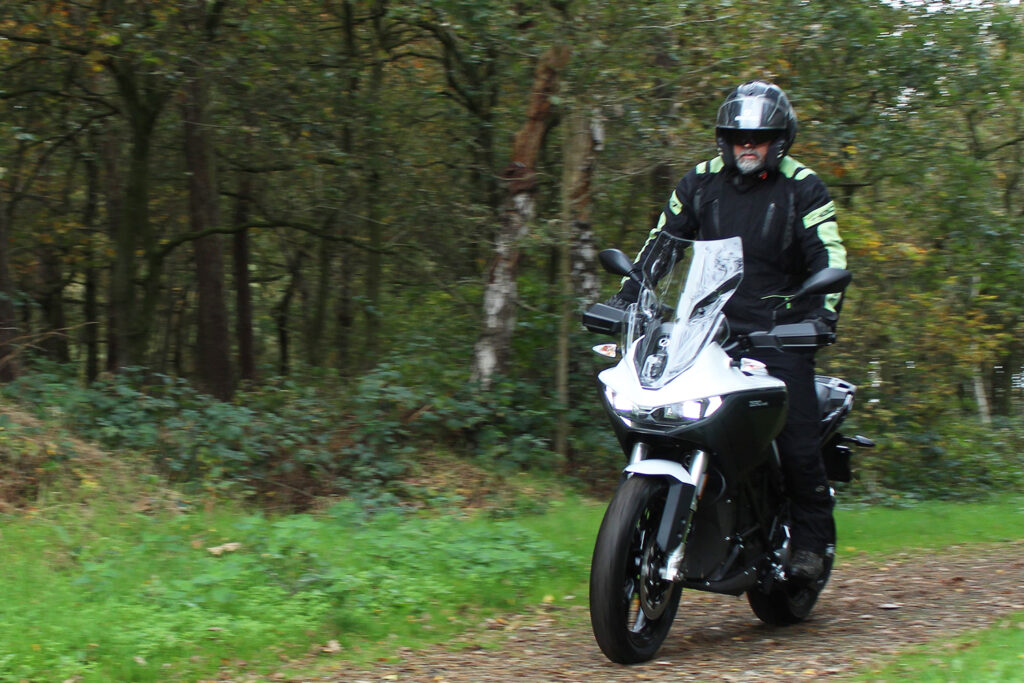
Despite ‘DSR’ in the model name designation, this Zero DSR/X has nothing to do with the earlier and previous DSR Models from Zero Motorcycles. The new DSR/X follows the sporty SR line based on a reinforced tubular frame from the SRS, which should be able to handle the adventurous nature of the DSR/X. The question remains, however, can the DSR/X live up to its adventurous ambitions with this sporty DNA? The 17.3 kWh battery, the long-travel suspension, 220 NM instant torque, 100 hp and the off-road traction control / ABS, do create the conditions for adventure.
A direct comparison with current fuel adventure bikes is not entirely fair due to the state of the art and the aforementioned “fossil” infrastructure. In this base version, Zero specifies a range of 180 km in combined road use and 137 km highway range at 113 km/h. Keep in mind that heavy use of the motorcycle quickly reduces these values. Therefore, as a user you will have to choose between distance and fun.
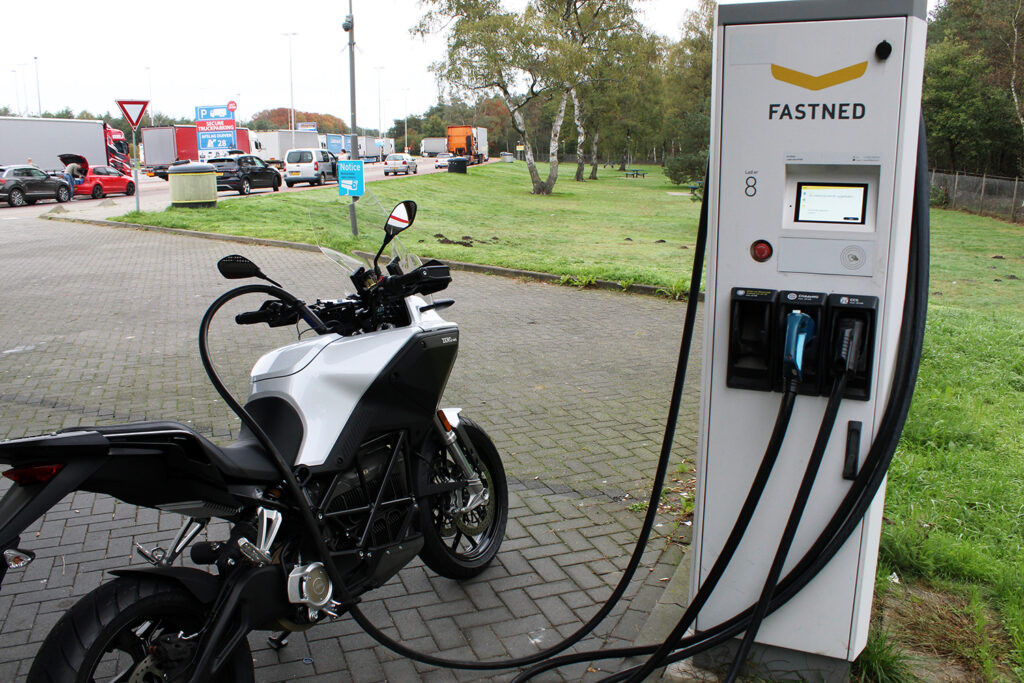
The DSR/X has a Granny charger for charging at the wall outlet and an internal 6 kW AC charger for charging at the charging station. Optional are a “Powertank” with which you can expand the battery capacity to 20.9 kWh and/or a charge tank that increases the charging speed to 12 kW. Indeed, and/or, this extra charger and extra battery cannot be placed at the same time. More about that later.
The DSR/X also features a fully adjustable 47 mm Showa SFF-BP fork and a piggy-back reservoir shock with 190.5 mm of travel (front and rear). The 19-inch cast wheels at the front and 17-inch rear with Pirelli Scorpion Trail II tires are intended for the public road. Optionally there is also a set of 19 and 17 inch spoke wheels available with Pirelli Scorpion Rally STR tires. The DSR/X has a seat height of 32.6 inches (828 mm) and is equipped with a Bosch-developed MSC (Motorcycle Stability Control). The all-electric DSR/X adventure features Standard, Eco, Sport, Canyon and Rain driving modes. The MSC can be adjusted per mode, including off-road traction control and ABS settings, with the aim of making the DSR/X even more drivable.
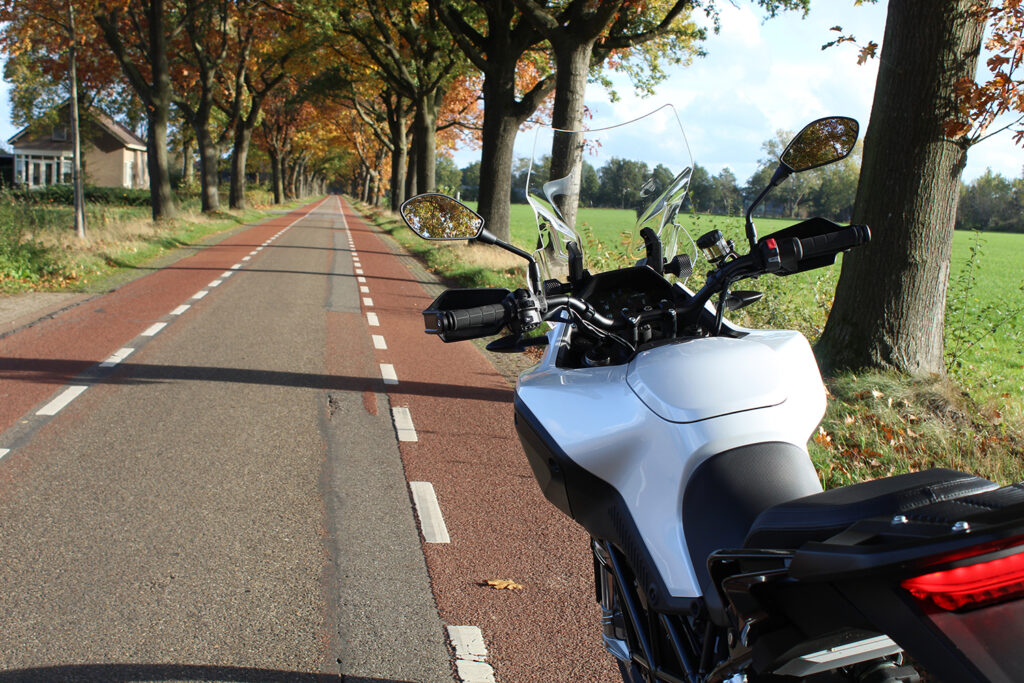
I took the DSR/X on the highway, back roads and trails with alternating firm and loose surfaces. The five driving modes adapt not only the throttle response to the selected mode, but also the brake regeneration. Eco mode gives the least power and regenerates a lot during engine braking, while Rain mode favors smooth braking and power delivery. Sport and Canyon modes give the most power with Canyon mode treating you to a similar ECO mode regeneration.
Equipment
Electric vehicles are known for instant torque, but Zero has tuned the throttle response in such a way that it won’t surprise you. Even in the powerful Sport and Canyon modes, you can drive through traffic with extreme precision with the DSR/X. With an adventure motorcycle-appropriate weight of 247 kg and a low center of gravity, the DSR/X has a remarkable agility. The twin radial-mount J-Juan (Brembo) calipers engage twin 320 mm discs. The braking effect is powerful, excellently dosable and, thanks to the radial master brake cylinder, very communicative. However, this is less important than we are used to due to regenerative braking on the electric motor. In practice, you hardly use your brakes during normal driving in ECO and Canyon mode, at most to brake a little. The 60-inch wheelbase ensures that the DSR/X maintains a straight line under braking. The front fork dive associated with braking can be fine-tuned with the adjustable compression, damping and preload settings at the front fork.
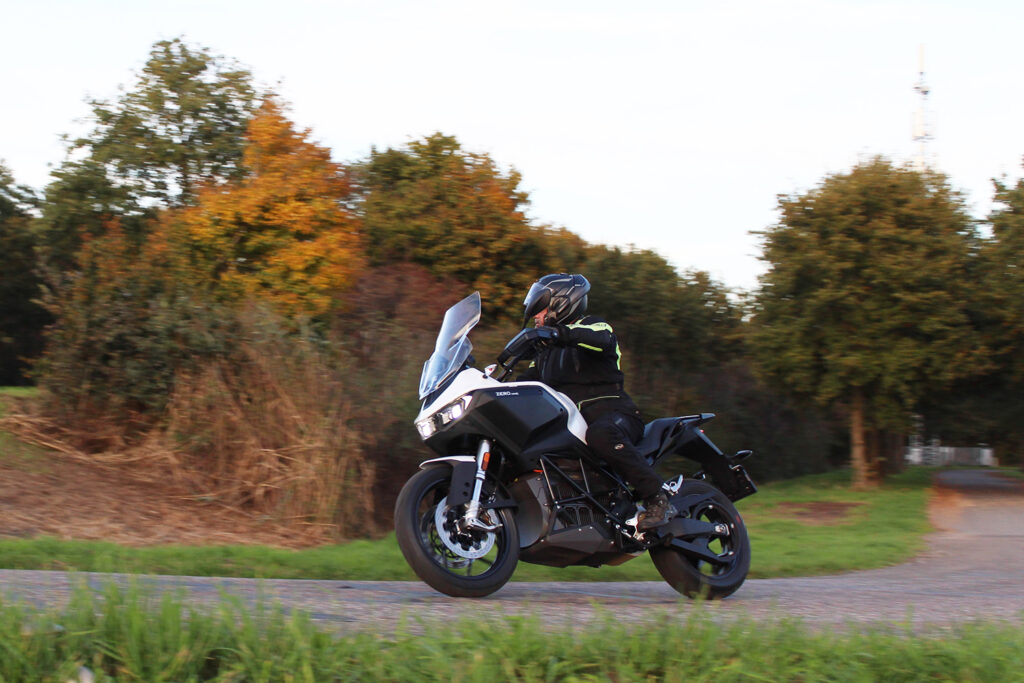
Off road
This isn’t Zero’s first off-road motorcycle. The brand’s FX, DS and DSR models all have off-road capabilities. None of those electric dual-sports have 225 Nm of torque and a weight of 247 kg. To contain the much heavier and more powerful DSR/X Adventure, Zero enlisted the help of Bosch engineers. This collaboration has resulted in Motorcycle Stability Control technology being fitted with the goal of safely transferring power delivery from the Zero trolling motor to the rear wheel. Of course it is not the case that you can throw the DSR/X into every corner with impunity. It is still possible to break out the rear wheel, but the MSC system prevents the rear wheel from breaking out.
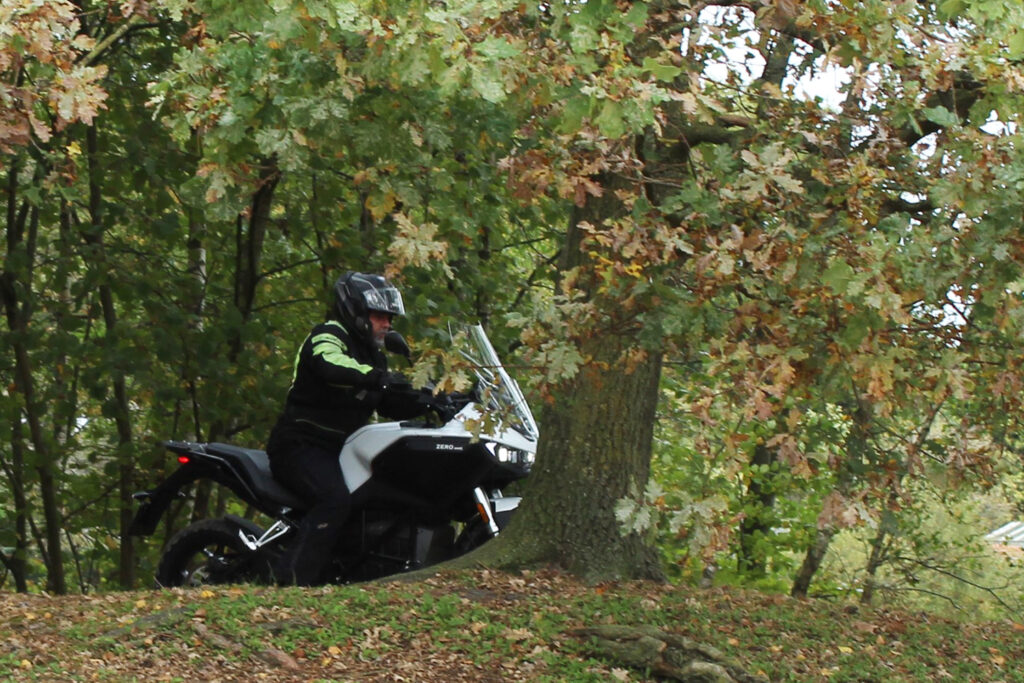
With the off-road traction control and ABS settings, the rider can also lock the rear brake in a controlled manner to keep the bike in line should the need arise. The absence of engine vibrations, noises and other user actions – which are necessary for a combustion engine – help you concentrate better on demanding off-road tasks. Standing on the footpegs feels comfortable due to the narrow base of the battery, for larger riders the handlebars may be a bit too low. As far as known, Zero does not yet have handlebar risers available for this purpose.
I limited myself to dirt trails and a little jaunt in loose sand. The Pirelli Scorpion Trail II tires don’t provide enough grip for a loose surface. A set of real off-road tires would push the limits of the DSXR even further, but the question is whether you would want that with an Adventure. For off-road use, Zero recommends the standard mode. After each ride, regardless of off-road settings, the system will return to default mode. After each stop where you turn off the engine, you will have to reset the off-road settings. Not a problem in itself, but it takes a while before you know your way around the dashboard via the mode button on the left handlebar. But that’s a matter of getting used to the interface. A range for this light off-road use is around 200 km.
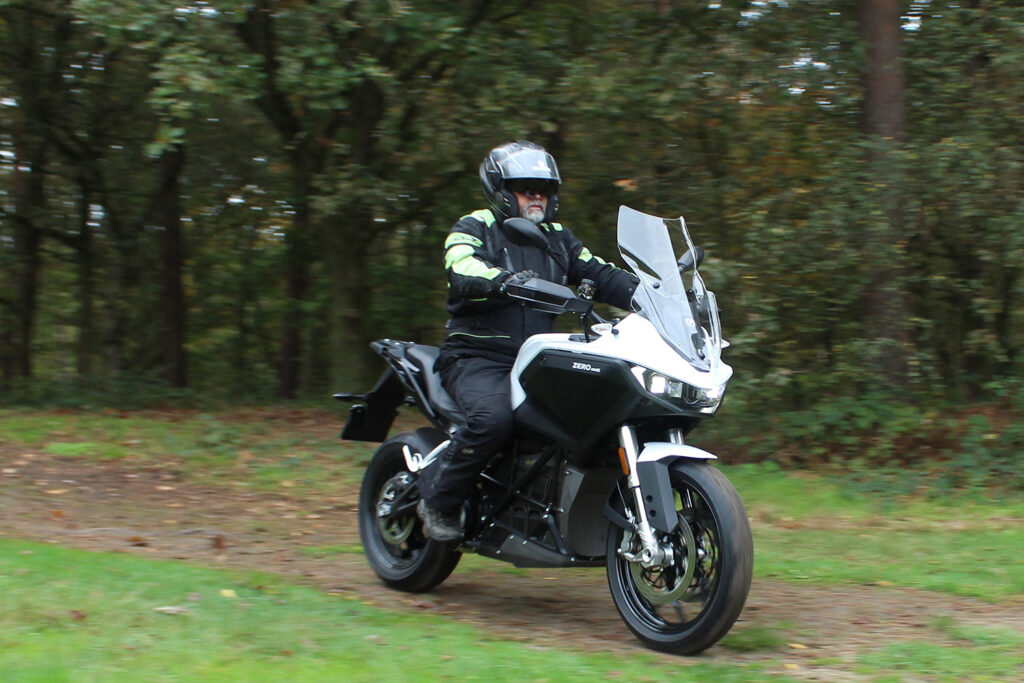
Touring
You mainly use an adventure for touring on public roads. The riding position and wind protection combined with the smooth power delivery provide an extremely handling and easy to ride motorcycle. The Canyon mode is my preference for powerful acceleration and good brake regeneration, so you hardly have to use the brakes. Driving in these conditions, the Zero DSR/X will get you between 170 and 190 functional kilometers. Of course depending on the (weather) conditions. You can take luggage with you in an optional suitcase set or some smaller items in the space where the tank is normally located. Here you can also charge your electronics via 2 USB ports. There is also luggage space on both sides in the top half that you can open with an included torque key. If desired, you can expand the range to 20.9 kWh with a power tank, an extra battery that is mounted in the “tank” space. If you choose for more charging speed, the power tank option is not possible. Both are mounted in the same place.

On the highway
The adventure rider prefers paved and unpaved back roads, but will still have to take a highway regularly to bridge the distance to his adventure location. The DSR/X is a comfortable travel companion with an extremely smooth and powerful engine, has a pleasant seating position, no disturbing vibrations and you are well protected behind the – in this case – extra high windshield. This ‘window’ keeps you well out of the wind / turbulence. If you are taller than 1.80 meters your head will end up in the turbulence. The DSR/X feels stable and takes long turns effortlessly and comfortably. The range specified by Zero of 137 km at 113 km/h is not achieved at 100% battery charge. I drove the applicable 100 km / h limit on the navigation with cruise control, in ECO mode and tailwind and I reached 120 km with the last percentages on the display. Keep in mind that the charging stations are not exactly at that distance from each other. In practice, you have to count on a practical range of 100 km on the highway. There is also a possibility to charge the battery up to 110%. Then you can add another 10-15 kilometers to the range. You have to set this extra range option manually every time you want to use it. The 6 kW charger fitted as standard does require patience to recharge sufficiently. Count on a small 2 hours to 80% battery charge if you have driven the battery almost empty, like me.
Conclusion
The DSR/X is nicely assembled. Engine, chassis and electronics are well balanced, the DSX/R is easy to drive, comfortable and there is the right set-up for everyone in the desired conditions. Many adventurous riders travel distances on the highway before reaching their adventure. If you want to cover a considerable distance via the highway in a relatively short time, that is not possible on the standard DSR/X. Firstly, the battery is too small to cover a greater distance with a brisk drive. Second, the standard 6 kW AC charger charges too slowly. In addition, the AC type 2 chargers on the highway are few and far between, the DC fast charger is increasingly common there. The range is sufficient for an average tour and or light all-road ride. But here too, the 6 kW charging speed requires patience to make a longer journey. The option for a battery extension or a 12 kW charging system is a personal consideration. However, these options drive up the price of the DSR/X considerably. The DSR/X raises the bar for electric motorcycling once again. The addition of an even faster (DC) charging system would considerably increase practical usability, especially with the upcoming expansion of the European (fast) charging infrastructure in mind. But adventure driving as we know it with a fuel engine is not (yet) possible. For the time being, with the DSR/X you still have to choose between distance and patience or fun closer to home.
Price (Belgium/The Netherlands): from 26,995,- EUR